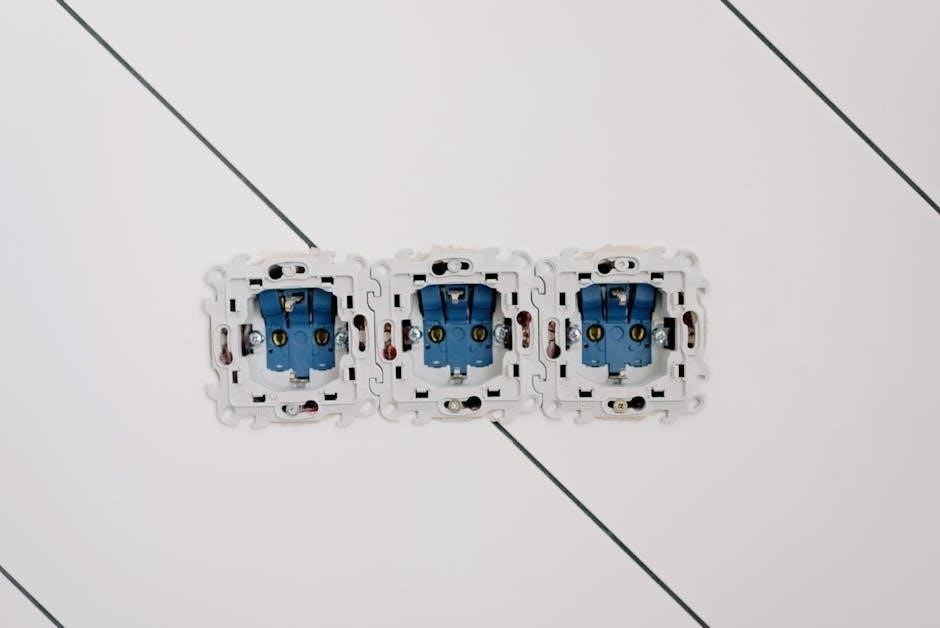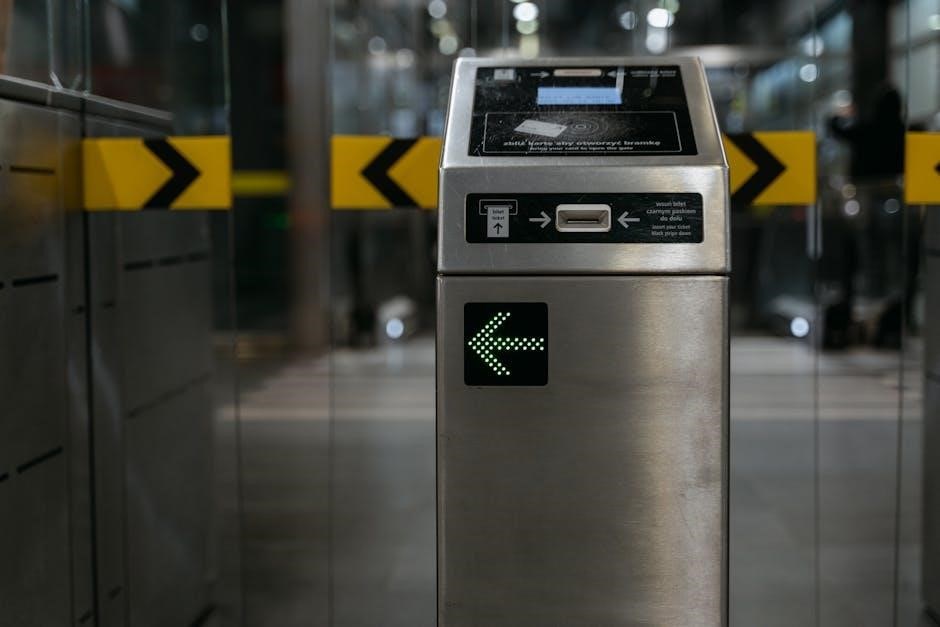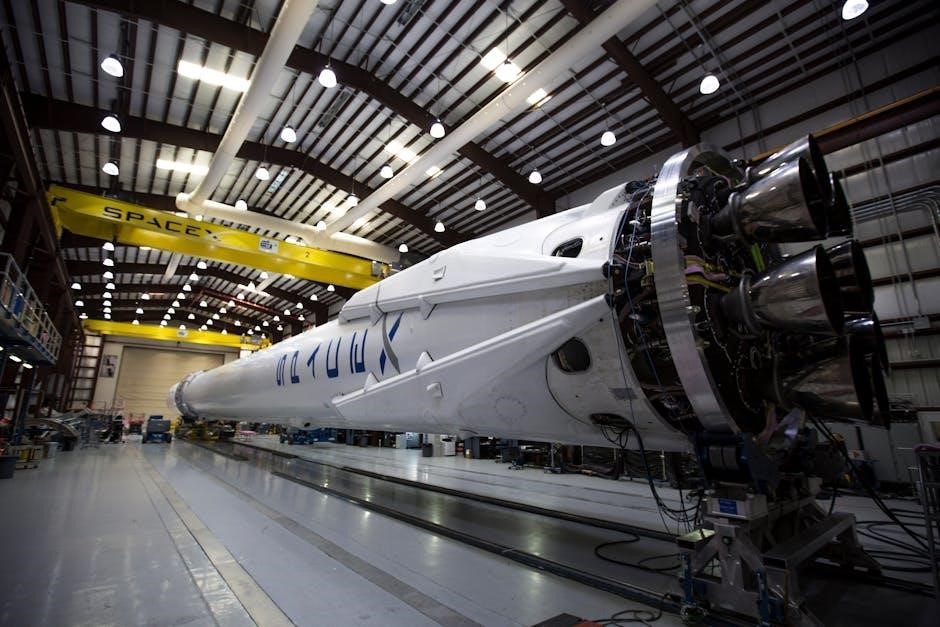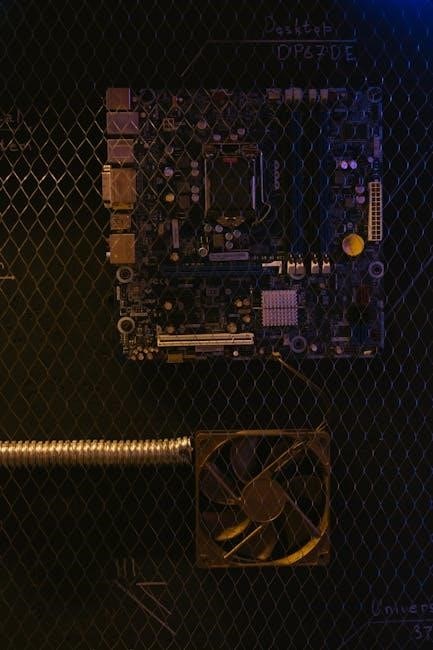Sprinkler system design involves planning, installing, and maintaining efficient water distribution systems․ It requires understanding components, water availability, and proper installation techniques for optimal performance․
Importance of Sprinkler Systems
Sprinkler systems are essential for efficient water distribution, ensuring uniform irrigation and water conservation․ They play a critical role in maintaining healthy landscapes, crops, and lawns by delivering water directly to roots, reducing evaporation and runoff․ In agriculture, sprinkler systems enhance crop yields and water use efficiency, while in residential settings, they improve lawn aesthetics and property value․ Additionally, smart irrigation controllers and advanced technologies integrate with sprinkler systems to optimize water usage and reduce waste․ Properly designed systems also support environmental sustainability by minimizing water consumption and protecting soil health․ Overall, sprinkler systems are a vital tool for managing water resources effectively in both urban and rural areas․
Basic Components of a Sprinkler System
A sprinkler system consists of several key components essential for its operation․ These include pipes and fittings, which distribute water throughout the system, and sprinkler heads, which deliver water to the target area․ Valves control water flow, while pumps or water sources provide the necessary pressure․ Controllers or timers automate the irrigation schedule, and filters prevent debris from clogging the system․ Additionally, check valves and backflow preventers ensure proper system operation and safety․ Each component must be selected and installed correctly to ensure efficient water distribution and system longevity․ Understanding these basics is crucial for designing a functional and reliable sprinkler system․

Planning and Design Process
Planning involves assessing water availability, measuring the irrigation area, and selecting suitable components․ Design ensures efficient water distribution and system performance, using layout guides and tools for accuracy․
Assessing Water Availability and Pressure
Evaluating water availability and pressure is crucial for sprinkler system design․ Determine the water source, whether municipal, well, or surface water, and measure flow rates and pressure using gauges or meters․ Ensure the water supply meets peak demand during irrigation cycles․ Pressure tests help identify if boosters or regulators are needed․ Low pressure can reduce coverage, while excessive pressure may damage equipment․ Accurate assessments prevent system inefficiencies and ensure proper hydraulic design․ Consult local water authorities for specific requirements and permits․ Proper water availability ensures the system operates efficiently, delivering consistent irrigation across the entire area․ This step is foundational for a reliable and effective sprinkler system design․
Measuring and Mapping the Irrigation Area
Accurate measurement and mapping of the irrigation area are essential for effective sprinkler system design․ Use tools like measuring tape, GPS, or drone surveys to determine the layout of the land․ Create a detailed map highlighting obstacles, slopes, and water sources․ Identify zones with varying water requirements to ensure efficient coverage․ This step helps in selecting the right sprinkler heads and nozzles, optimizing pipe placement, and avoiding overwatering․ Proper mapping also aids in creating a balanced hydraulic design, ensuring even water distribution․ By understanding the land’s topography and features, you can design a system that adapts to the specific needs of the area, improving efficiency and reducing water waste․
Selecting the Right Sprinkler Heads and Nozzles
Selecting the right sprinkler heads and nozzles is crucial for efficient irrigation․ Choose sprinkler types based on coverage area, water pressure, and application needs․ Fixed spray heads are ideal for small, uniform areas, while rotor heads cover larger spaces and adapt to varying pressures․ Micro-sprinklers are suitable for precise watering in gardens or orchards․ Nozzles vary in flow rates and spray patterns, ensuring tailored water distribution․ Matching the correct nozzle to the sprinkler head optimizes performance, reduces overwatering, and minimizes waste․ Consider factors like soil type, plant requirements, and system pressure to make informed decisions․ Proper selection ensures uniform irrigation and long-term system efficiency․

Sprinkler System Layout and Installation
Creating a detailed layout plan ensures proper pipe installation and spacing of sprinkler heads․ This step is crucial for efficient water distribution and system performance․
Creating a Layout Plan
Creating a detailed layout plan is essential for efficient sprinkler system installation․ Start by assessing the irrigation area and marking sprinkler head locations on graph paper․ Ensure proper spacing based on water coverage and soil type․ Identify the water source and plan pipe routes to minimize waste․ Use landscape paint to mark trenches and sprinkler positions for clarity․ Consider zones for different watering needs and ensure valve boxes are accessible․ Measure and label all components accurately to avoid installation errors․ Proper planning ensures even water distribution, reduces waste, and extends system longevity․ Tools like graph paper and landscape paint aid in creating an accurate and functional layout design․
Installing Pipes and Fittings
Installing pipes and fittings requires careful planning to ensure a leak-free and efficient sprinkler system․ Begin by trenching the ground to the recommended depth, ensuring proper slope for water flow․ Use durable, UV-resistant pipes suitable for outdoor conditions․ Connect pipes using compatible fittings, such as couplers, elbows, and tees, ensuring tight seals․ Install check valves to prevent backflow and reduce wear on the system․ Flush the pipes before connecting sprinklers to remove debris․ Test the system for leaks under pressure and make necessary adjustments․ Proper installation ensures even water distribution, minimizes maintenance, and extends system lifespan․ Always follow manufacturer guidelines for specific pipe and fitting requirements․
Mounting Sprinkler Heads and Valve Boxes
Mounting sprinkler heads and valve boxes requires precision to ensure proper system functionality․ Sprinkler heads should be installed at the correct height, typically 6-12 inches above ground, using risers to adjust for uneven terrain․ Ensure they are spaced evenly and aligned to cover the intended irrigation area without overlap․ Valve boxes must be buried at a depth that allows easy access, usually 6-8 inches underground, with lids flush to the ground․ Proper placement prevents damage from mowing or foot traffic․ Use durable materials and secure connections to avoid leaks․ Make sure to allow space for soil settling and sod growth around sprinkler heads․ Follow manufacturer guidelines for installation to ensure optimal performance and longevity of the system․

Design Considerations
Design considerations include hydraulic planning, pipe sizing, and zone division for efficient water distribution, ensuring optimal coverage and pressure across the irrigation area․
Hydraulic Design and Pipe Sizing
Hydraulic design ensures efficient water distribution by calculating pressure and flow rates․ Proper pipe sizing balances water velocity and pressure loss, preventing damage and ensuring even coverage․ Factors like friction loss, pipe material, and system demand are critical․ Correct sizing avoids excessive pressure drops, maintaining sprinkler performance․ Best practices recommend using hydraulic calculations or software for accuracy․ Incorrect sizing leads to inefficiency or system failure․ Always follow design manuals for optimal results․
Zone Division for Efficient Irrigation
Zone division is critical for efficient irrigation, allowing tailored water distribution to specific areas․ Each zone should be designed based on soil type, plant water requirements, and sun exposure․ By dividing the irrigation area into zones, water is delivered precisely where needed, reducing waste․ Proper zoning ensures uniform coverage and prevents overwatering or underwatering․ Factors like sprinkler type, pressure, and flow rate must align with zone specifications․ Advanced systems integrate smart controllers to automate zone operation, optimizing water use and plant health․ This approach enhances efficiency, conserves water, and supports sustainable irrigation practices․ Proper zone division is essential for maximizing system performance and resource utilization․
Integration with Soil and Crop Requirements
Integrating sprinkler systems with soil and crop requirements ensures optimal water application and plant growth․ Soil type, texture, and moisture-holding capacity must be considered to prevent overwatering or nutrient leaching․ Crop water demands vary by species, growth stage, and climate, requiring tailored irrigation schedules․ Sprinkler systems should be designed to deliver water uniformly while matching crop root depths․ For instance, drip-less sprinklers and precision nozzles can target specific areas, reducing evaporation and runoff․ Advanced systems integrate soil moisture sensors to adjust irrigation dynamically․ This integration enhances water efficiency, promotes healthy plant development, and minimizes environmental impact․ Proper alignment with soil and crop needs is vital for sustainable and effective irrigation practices․

Installation Tools and Materials

Essential tools include tubing cutters, compression fittings, and ground paint․ Materials like PVC pipes, sprinkler heads, and valves ensure a durable and efficient irrigation system․
Essential Tools for Sprinkler Installation
Key tools for sprinkler installation include tubing cutters, compression fittings, and ground paint for marking layouts․ Pipe wrenches, drills, and Teflon tape are also crucial for secure connections․ Additionally, soil augers and trenching tools help with pipe laying, while sprinkler head adjustment tools ensure proper water distribution․ Pressure test kits verify system integrity before operation․ These tools streamline the process, ensuring a professional-grade setup․ Proper tool selection prevents leaks and ensures efficient system performance, making them indispensable for both residential and agricultural installations․
Recommended Materials for Durability
Durable materials are crucial for long-lasting sprinkler systems․ PVC and polyethylene pipes are popular choices due to their resistance to corrosion and flexibility․ Brass or stainless steel fittings are recommended for their strength and resistance to wear․ High-quality sprinkler heads made from durable plastics or metals ensure consistent water distribution․ Using UV-resistant materials for outdoor components prevents degradation from sunlight․ Properly selecting materials ensures system longevity and minimizes maintenance needs․ Compliance with local plumbing standards is also essential for safety and reliability․
Soil-friendly materials, like corrosion-resistant pipes, are ideal for underground installations․ Durable valve boxes and manifolds protect system controls from environmental factors․ Investing in quality materials ensures efficient performance and extends the system’s lifespan, reducing long-term costs․

Maintenance and Troubleshooting
Regular inspections and cleaning of sprinkler heads ensure optimal water distribution․ Winterizing the system prevents freezing damage, while checking for leaks and blockages maintains efficiency and longevity․
Regular Maintenance Practices
Regular maintenance ensures the sprinkler system operates efficiently and effectively․ Inspect sprinkler heads monthly for clogs or damage, and clean or replace them as needed․ Check valves and pipes for leaks, tightening connections where necessary․ Winterize the system by draining water to prevent freezing, typically using air compressors to blow out lines․ Test the system quarterly to ensure proper coverage and adjust sprinkler angles or spacing if needed․ Keep records of maintenance activities to track performance and plan future upkeep․ Annual professional inspections are recommended to identify hidden issues․ Regular maintenance extends system lifespan, saves water, and maintains uniform irrigation across the landscape;
Common Issues and Solutions
Common issues in sprinkler systems include clogged nozzles, leaky pipes, and uneven water distribution․ To address these, inspect and clean sprinkler heads regularly, and replace worn-out nozzles․ For leaks, tighten pipe connections or replace damaged sections․ Uneven coverage can be resolved by adjusting sprinkler angles or spacing․ Another issue is system shutdowns due to excessive pressure or valve failures․ Install pressure-regulating valves and ensure proper valve installation to prevent this․ Additionally, winter freezing can damage pipes; winterize the system by draining water and using air compressors to clear lines․ Regular inspections and timely repairs are essential to maintain system efficiency and prevent water waste․

Advanced Features in Sprinkler Systems
Advanced sprinkler systems integrate smart controllers, sensors, and water-saving technologies․ These features optimize water usage, reduce waste, and offer customizable irrigation schedules for enhanced efficiency․
Smart Irrigation Controllers
Smart irrigation controllers are advanced devices that optimize water usage by adjusting irrigation schedules based on real-time data․ They utilize sensors to monitor soil moisture, temperature, and precipitation levels, ensuring plants receive the right amount of water․ These controllers can integrate with weather forecasts to skip watering during rain or high winds, reducing waste․ Some models offer remote access via smartphones, allowing users to adjust settings or receive alerts for system issues․ Smart controllers also learn from historical data to improve efficiency over time․ By automating and refining irrigation processes, they help conserve water while maintaining healthy landscapes․ This technology is increasingly popular in both residential and agricultural settings for its convenience and environmental benefits․
Water Conservation Technologies
Water conservation technologies in sprinkler systems focus on optimizing water use while maintaining plant health․ Drip irrigation and precision sprinklers deliver water directly to roots, reducing evaporation and runoff․ Rain and soil moisture sensors detect existing moisture levels, adjusting irrigation schedules to prevent overwatering․ Weather-based controllers use local weather data to tailor watering amounts, avoiding unnecessary irrigation during rain or high winds․ These technologies integrate seamlessly with smart controllers, offering real-time adjustments and remote monitoring․ Advanced systems also incorporate flow sensors to detect leaks, ensuring efficient water distribution․ By combining these innovations, water conservation technologies enhance irrigation efficiency, reduce waste, and promote sustainable practices, making them essential for eco-conscious and cost-effective sprinkler system design․

Case Studies and Examples
Case studies highlight successful sprinkler system designs, showcasing efficient irrigation solutions․ Examples include Toro’s design service and smart technologies like soil moisture sensors, optimizing water use․
Residential Sprinkler System Design Examples
Residential sprinkler systems often feature automated designs that optimize water use and landscape health․ Toro’s sprinkler design service provides tailored layouts for homeowners, ensuring efficient irrigation․ Smart controllers and soil moisture sensors are commonly integrated to adapt watering schedules to weather conditions․ Many systems include drip-less sprinklers like the SpinNet model, which prevents water waste․ Design guides, such as those from Rain Bird, offer step-by-step plans for installing sprinkler heads, pipes, and valves․ These examples emphasize balancing aesthetics with functionality, ensuring even coverage and minimal runoff․ Proper spacing and zoning are highlighted to match lawn areas, gardens, and slopes, ensuring every zone receives the right amount of water․
Agricultural Irrigation System Case Studies
Agricultural irrigation systems are tailored to crop and soil requirements, ensuring efficient water use․ Case studies highlight center-pivot systems for large-scale farms, optimizing water distribution with precise nozzle spacing․ Drip irrigation is often used in smaller, irregularly shaped fields to minimize runoff․ Smart controllers integrate soil moisture sensors, adjusting irrigation schedules based on weather data․ Toro’s design service provides customized layouts for agricultural settings, balancing water conservation with crop needs․ These systems often feature zone division, allowing targeted irrigation for varying soil types and plant demands․ Advanced technologies, such as IoT-enabled controllers, offer real-time monitoring for optimal performance․ Such case studies demonstrate how sprinkler systems can be adapted to diverse agricultural landscapes, enhancing productivity while reducing water waste․

Future Trends in Sprinkler System Design
Future trends include IoT integration, automation, and smart controllers for efficient water management․ Advanced technologies focus on sustainability, precision irrigation, and data-driven designs to optimize resource use․
Integration with IoT and Automation
IoT and automation are revolutionizing sprinkler systems by enabling real-time monitoring and control․ Smart controllers now integrate with soil moisture sensors, weather stations, and flow meters to optimize water usage․ Automated systems can detect leaks and pipe breaks, sending alerts to prevent waste․ Advanced algorithms analyze data to adjust irrigation schedules based on plant needs and climate conditions․ This integration enhances efficiency, reduces manual intervention, and promotes water conservation․ IoT-enabled devices also allow remote system management via smartphones or tablets, ensuring seamless operation․ By leveraging these technologies, modern sprinkler systems achieve higher precision and sustainability, aligning with environmental goals and user preferences for smart, connected solutions․
Sustainable and Eco-Friendly Designs
Sustainable sprinkler system design focuses on optimizing water use while minimizing environmental impact․ Modern systems incorporate water-saving technologies like drip irrigation and smart controllers that adjust watering based on soil moisture and weather conditions․ These designs reduce water waste and lower energy consumption․ Rainwater harvesting systems are also integrated to collect and reuse water, further enhancing sustainability․ Low-flow nozzles and highly efficient sprinkler heads are recommended to conserve water․ Additionally, eco-friendly materials, such as recycled pipes and energy-efficient pumps, are increasingly used․ These designs not only protect natural resources but also reduce long-term maintenance and operational costs, promoting environmentally responsible irrigation practices for residential and agricultural applications․
A well-designed sprinkler system ensures efficient water use, proper installation, and optimal performance, addressing soil and crop needs while promoting sustainable irrigation practices․
Effective sprinkler system design requires careful planning, starting with assessing water availability and pressure to ensure sufficient supply․ Measuring and mapping the irrigation area helps in creating accurate layouts․ Selecting the right sprinkler heads and nozzles ensures uniform water distribution․ Hydraulic design and proper pipe sizing are critical to maintain optimal water flow․ Dividing the system into zones enhances efficiency and reduces waste․ Integration with soil and crop requirements ensures tailored irrigation․ Regular maintenance practices, such as flushing pipes and inspecting sprinkler heads, are essential for longevity․ Troubleshooting common issues like leaks or clogged nozzles ensures system performance․ By following these principles, a sprinkler system can achieve efficient water use and promote sustainable irrigation practices․
Final Tips for Effective Sprinkler System Design
For a successful sprinkler system, prioritize proper planning and use of tools like ground paint for layout accuracy․ Test the system before full installation to identify and fix issues early․ Regular maintenance, such as flushing pipes and inspecting sprinkler heads, ensures long-term efficiency․ Consider smart irrigation controllers to optimize water usage and reduce waste․ Ensure all pipes and fittings are installed correctly to avoid leaks and damage․ Adjust sprinkler heads seasonally to match water needs, and invest in durable materials for longevity․ Finally, explore advanced features like soil sensors and IoT integration to enhance system performance and sustainability․
